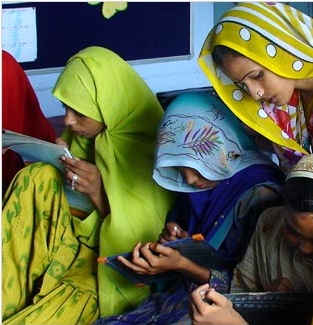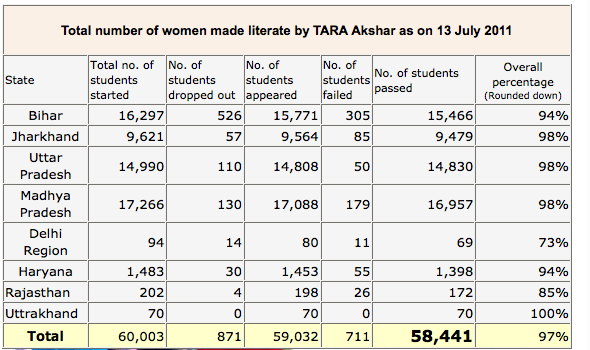The Bottom of the Pyramid needs Reading ICT Solutions too
While you stand there smugly surveying your sea of shiny computers in your state-of-the-art school computer centre, please spare a thought for the billion or so people who never made it to school, or who dropped out after a year or two or three, and never even learned to read and write.
Most of them are forever doomed to a subsistence existence below the poverty line in agricultural communities, or to eke out an existence in the mega-slums of our mega-cities. These people have been written off by some observers as a lost generation for whom there’s no hope. It’s only a billion people. Better luck next lifetime. But we believe there is a way to change this through literacy.
History
Seven years ago I stood in a field in Punjab, India, listening to the District Health Officer tell me that my Health Education program to reduce child morbidity was doomed to failure because my target audience would never be able to read my leaflets and brochures. “But the literacy rate here is 64%”, I protested. He fell about laughing at my naïve faith in government statistics.
Success!
So I packed my bags and moved to Delhi and built a computerised literacy program called Tara Akshar. We used a technique nobody had used before. The outcome was that 60,000 completely illiterate women, aged 8 to 80, were taught to read and write in a 55 hour course. The combined drop-out and failure rate was less than 5%. I believe these kinds of numbers are unheard of in any voluntary Indian education program.
Why it works
The secret of our success was animated Laubach memory hooks embedded in a cartoon serial. Let me explain. Laubach was a chap in the 1930s who said you should teach letter recognition by drawing pictures in which two things happen:

- The picture is of an object that begins with the letter you are trying to teach; for example, if you are trying to teach the letter S, then you could show a picture of a snake.
- The picture looks like the letter. So make sure the snake is in an S shape:
The purpose of this is to give a great big clue to the reader as to what sound the letter represents so he/she does not have to remember it.
It’s an obvious, really. So we have Ws that look like waves, and Bs that look like bats, and so on. We cannot understand why all early learning systems don’t work like this. We teach completely illiterate tribal women in remote parts of India to recognize all 30+ consonants of the Hindi alphabet in only 10 hours using this method.
So we designed a picture using Laubach principles for each letter of the alphabet (all the consonants, plus both cases for the vowels). Then we went one stage further and animated the letter morphing into the object and back again. In other words, the letter S turns into a snake, and then back into an S. Then we show the animation on a laptop. We ended up with about 50 animations of the Hindi alphabet, and make each one a character in a multi-episode story.
Every day, our students come to class, and watch the latest episode of the story. Then we test them using video-game style quizzes on the laptop, and then they do 20 minutes writing practice while the computer shows an animation of how to write the letter. Then we show the episode again, and test again, and writing practice again – no activity takes more than 20 minutes. And we use flash cards, and we use posters, and we use special playing cards, as well as writing books and reading books.
After each 100 minute lesson, we send them home. They all turn up the next day because
- It’s easy, they don’t have to try to remember anything
- It’s fun
- It’s a social event
The Indian Government has now run very successful pilots of the program and recognized it as “best practice.”
Of course, letter recognition is only one of several facets of teaching reading and writing. After letters, we go onto syllables, then words, then sentences, then onto our reading books. Our English language version has a full-blown phonics section of course.
After Literacy
Literacy by itself makes a huge difference to self-esteem, the balance of power in the family, the length of time children stay in school, and almost certainly the birth-rate. (And that’s why it’s probably an excellent way of reducing carbon emissions.) But to be really successful, all the follow-on courses to bring people back into the learning mainstream are required. We have now built courses for numeracy, ethics, how to eradicate shyness, how to participate in an organization, how to follow instructions, how to study, how to improve memory and many more besides.
English and other languages
The efficiency of this program is so high that it easily offsets the cost of the technology. My ambition is to get it used in every country with a literacy problem. Which is probably everywhere but about 3 countries, I believe.



It seems that Wayan has done everything. Reading this and many other reports that is the impresssion one gets. Is Wayan a human being or just a robot?
The article was written by me, Victor Lyons, not Wayan.
The kind of experience Tara-Akshar has created is interesting indeed. Just that we have been hearing the figure of 60,000 for the past few years. From the multi-site, multi country experience that we have, they can improve their efficiency a dozen times and the quality of what they teach a hundred times by using OLPC XO. They need to try that out. They are talking reasonable numbers and they can start with say 10% learning with OLPC and can test it out.
We looked at One-Laptop-Per-Child. But the screen was not big enough for our requirements, and the sound quality was not good enough for our requirements.